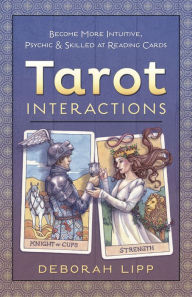When I first picked up Tarot Interactions, I knew it was going to be different than other tarot books I’d read in the past. It seemed that the book wanted to help the reader become more intuitive using the cards, developing psychic ability. As I read further, however, I realized that this book presents a state of mind, if you will, about the tarot that I had never before considered.
A “tarot interaction” according to author Deborah Lipp, is a way “to talk about different ways in which we can relate to, and use, tarot cards.” In other words, the tarot cards interact with the reader and the client, but they also interact with each other. Lipp says that the quicker you go “off book” the more your psychic ability with the cards will develop, and I totally agree.
One of the most interesting parts of the book to me was Lipp’s understanding of tarot reversals. Many readers, myself included, don’t use them, but I really enjoyed her explanation: Upright cards are “stable”, while reversed cards are “unstable”. To me, that alone was worth the time invested in this book. I had never heard anyone explain the concept exactly that way and my mind was blown.
The book has many of the standard tarot book features, including various spreads, exercises, and meditations. I especially enjoyed the section on numbered patterns and the keywords associated with them—tarot threes are “outcome” and “flux”, for example—as well as an explanation of how a card changes based on its position in a spread. The idea of changing the tense of the verb to reflect where the card falls in a chronological layout like a past-present-future reading is exceptionally important.
I’m a huge gamer, and I found a chapter in this book that really spoke to me: tarot games. One of them is called tarot telephone. You keep a tarot deck by the phone and then when someone calls you cut the deck, draw a card, and make a quick prediction. Then you answer it, and write down what the outcome was. Of course, she admits that back when the game was invented, they were landlines; these days caller ID can give away a lot. But you can still do it; just keep your cell phone face down.
There are tons of excellent resources in this book, and while I can’t list them all, I’ll say that the small section on difficult clients would be a fantastic book all on its own!
Once you pick up this book you’ll want to take your tarot skills further, to push yourself. Before I started working with the concepts herein, I’d make sure I had a good grasp of the meanings of the cards without needing a book. As such, for people who want to go “off book”, especially for those who want to become professional readers, this work is an excellent way to do so.
This book isn’t one I’d recommend to tarot newbies. Overall, however, this is an excellent tarot resource for intermediate readers and up. I plan to keep it handy!
~review by John Marani
Author: Deborah Lipp
Llewellyn Worldwide, 2015
pp. 251, $19.50
Tarot Interactions: Become More Intuitive, Psychic & Skilled at Reading Cards

©
2010 - 2025
Facing North
